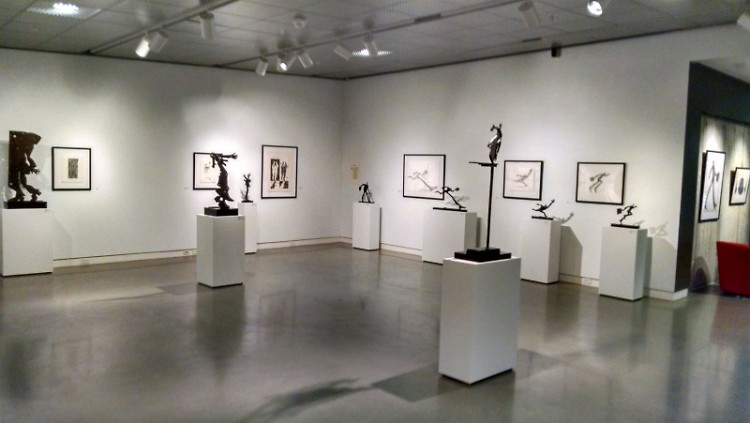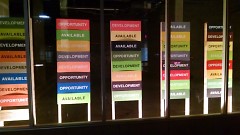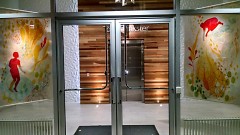If you made your way along the South Division business district last weekend, it would have been hard not to have absorbed some inspiration from all the temporary gallery spaces showcasing West Michigan's creative scene. With over 20 storefront spaces involved from Grand Rapids’ Fulton St. to Wealthy St., the entire district was permeated with installations, 2D/3D designs, shared contemplation, dialogue and the dwindling leaves of another passing fall.
Organized by Avenue for the Arts, this year's Free Radical Gallery once again offered an on-foot, door-to-door opportunity for those seeking to explore what some of our local artists are up to. It was almost like a trick-or-treat; except instead of being offered candy at each stop, we're offered food for thought (which is all the more delicious).
For my own exploration at this year's Free Radical, its 12th incarnation since 2002, I began at Urban Institute for Contemporary Arts (UICA), which starts at Fulton St., and worked my way down. This gallery space and that of its Division Ave. neighbor across the street, Tower Pinkster, are the ones I intended to document along the way. After spending considerable time rooting myself in UICA's offering and calmly perusing Tower Pinkster's own as I began my walk, there was more than enough creative stimulation to take away from these and reflect on further.
UICA's contribution offered to Free Radical this year was an exhibition providing a fresh look at the themes of Kirk Newman's career. Newman is a Texas-born sculpture and experimenter who taught in Kalamazoo and helped launch the Kalamazoo Institute of the Arts art school. His work in various media has focused on using the human figure to draw attention to the anxieties and humor associated with the modern business world. The exhibition at UICA, entitled Looking Forward: The Artwork of Kirk Newman, showcased this focus of his as it emerged over the course of his career. While I was here, I noticed this showcase spanned between 1968 and 2006 and that there were about 44 individual pieces making up the exhibit, with about a half of these being sculptures and half being painted or illustrated pieces.
The exhibition took place on their first and bottom floors and, after walking up UICA's ramp to the first, I was immediately exposed to the plethora of Newman's individual pieces on display. After reading the introduction statement elaborating on how the exhibition aimed to display his various uses of businessmen and more “primitive”-like figures to demonstrate the aforementioned anxieties and humor associated with the modern business world, this theme stood out through the pieces even from standing afar. While I took snapshots of each written statement associated with the exhibition to reflect on after, my shot of the introduction came up too blurry afterword to be able recall just how the curators articulated the evolving philosophy at play in Newman's work. However, I find this a positive in retrospect, as I'm left with what many others were probably left with after leaving the site: a vague impression of what was significant and thought-provoking about the artwork of Kirk Newman, minus a lot of the details.
What stood out to me as significant in the moment of perusing all of the various bronze sculptures of businessmen and similar 2D figures was how all of his work displayed was unified in its political and philosophical critique of our modern, corporately-structured culture. As one statement read, “figures are seen clutching their briefcases – their source of security and power – with one hand, while the other reaches anxiously, as if constantly anticipating the next all-important handshake.” This depicts accurately the mood of many of the pieces, as this symbolic businessman was displayed as always in motion and always in frantic postures that certainly don't look comfortable if one were to physically imitate them him or herself. This briefcase never left the symbolic businessman in any of his displays and I was glad to see that, as I followed the developing narrative underlying Newman's career-spanning work, his work in the 1980s began to depict businesswomen as well. Additionally, he began incorporating his interest in how the art of “primitive” cultures used dark shadows to express their own cultural evaluations into his work, which enabled a more comprehensive scope to his ongoing theme.
Aesthetically, this incorporation of “primitive” cultures' use of shadows connected with Newman's work through the vast majority of the sculptures and 2D prints on display being entirely black. Not only this, but the fact that many of the sculpture pieces had 2D prints directly behind them that mimicked as backdrops the exact postures of their corresponding sculpture figures only added to this “shadow” element. As I suspect was likely intended by the exhibition's curators, the 2D prints shadowed the sculptures. This, taken with the fact that many of the sculptures created their own physical shadows through UICA's lighting, enabled, in my eyes, a well-rounded experience that blurred the lines between the aesthetic and philosophical components at play.
Before I made my way onward to Tower Pinkster's exhibition, I took some time, as I observed many other participants doing, to bask in the environment and feel out the community and dialogue filling the two active floors. I've never been one to be proficient with gauging numbers, but at all times during my experience here, both floors were present with multiple groups of people silently engaging with the works and discussing among their accompaniers what they were seeing. As I found myself repeatedly attempting to move out of the way of certain displays since others were behind me trying to get a turn to see them, I'd say the turnout was fruitful and the energy here was lively. Several of UICA's team members seemed to be on hand as well as it was also the exhibition's opening reception, which gave anyone the opportunity to learn more about all of the art happening if they fancied to.
Upon leaving UICA, I crossed the street over to Tower Pinkster, an architecture and design firm, to stop in and see what their exhibition was about. As I attempted to open the door to begin my exploration, I was a little confused as the door was locked and I couldn't see a soul inside. It didn't take long to realize this wasn't any kind of mishap, but exactly how it should have gone: the exhibit here was meant to be viewed externally as a window display drawing our intention inward from the streets. There were two exhibits in view; one entitled House of Gold by artist/curator Taylor Greenfield and the other entitled The Landscape of this City is Violent and It Makes Me Nervous by artist Group Therapy and curated by Krzysztof Lower.
Presiding in the lobby entrance behind Tower Pinkster's transparent windows and dual-door, House of Gold was a mixed media installation of drawings and cut paper pieces. Lit up by the site's interior lighting during what had transformed at this point into a chilly Friday night, the exhibit was organized symmetrically inside with two corresponding drawings to the left and right of the door. With the white cut paper pieces covering the walls behind them, the drawings stood out to me and probably most others who walked past as the foreground and primary focus of what the artist wanted to display, with the white cut paper pieces serving as its background. The drawings looked as though they were made with watercolor paint and I almost imagine that they probably were; though the artists own description of the exhibit as an installation of “drawings and cut paper pieces” has me questioning my competency with identifying artistic materials. Either way, I enjoyed the color scheme involved of what looked like a scarlet red, mustard yellow, lime green, and baby blue. The drawings depicted two womanly figures on each piece engaging with various abstract shapes and the white cut paper pieces behind them were designed in a 3D, crinkled foil-like texture.
Displayed in the transparent windows to the right of this was The Landscape of this City is Violent and It Makes Me Nervous. With five wooden posts nailed with signs in various colors saying the words “OPPORTUNITY,” “DEVELOPMENT,” and “AVAILABLE” in miscellaneous orders, this exhibit was an installation “utilizing familiar language, a system of modularity (and chance), and site-specificity to interrogate the visual, physical, and economic landscape of Grand Rapids, MI” as the artist statement described. There were audio speakers in addition to the left and right projecting out sounds of cars, pedestrian banter, mainstream radio tunes, and general city-based cacophony.
I enjoyed the way Group Therapy's exhibit intentionally resonated with the hustle and bustle of the city outside it by drawing attention to this “hustle and bustle” in the first place. It inspired in me while here a re-embodied realization of just how noisy, distracting, and competitive trying to live in a city like Grand Rapids can feel at times. Surely this noisiness, distractedness, and competitiveness emerges in any living area congested with hurrying bodies, high hopes, and concentrated wealth, but these other areas aren't the areas I currently live in. Neither are these other areas the areas most of who participated in Free Radical, artists or not, currently live in. For all our various aspirations, most of us who have participated in this yearly temporary gallery have claimed this piece of land called Grand Rapids and West Michigan our home. To be able to experience such exhibits as this and all of the other exhibits a part of Free Radical this year while here are what help transform these feelings of modern anxiety Kirk Newman drew attention to through his own works into the sacred and positive feelings we associate with a shared community, culture, and dialogue.
All in all, as I mentioned in the beginning of sharing my experiences, I personally find that it would have been hard not to have absorbed some inspiration from all these temporary gallery spaces showcasing West Michigan's creative scene. As I continued on my walk down South Division Ave. over the course of this Friday night, there was no shortage of places to stop in to and find peaceful contemplation with the images and ideas artists around here are finding relevant enough to engage with through their works. From photography to typography to time-based projects, downtown Grand Rapids was made proactive host once again to artists of nearly all media. Combined with the grassroots-organized Lamp Light Music Festival having taken place for its 3rd year this same weekend in Grand Rapid's Eastown neighborhood and ArtPrize's wrapping up a little less than a month ago, the opportunities for creative growth and collaboration in this city make it difficult to argue against the momentum of Grand Rapid's creative culture. Of course, if you wanted to argue against this momentum, I'm sure most here would welcome this too. After all, it's this openness to critique that keeps us all growing and keeps life's passions fun in the process.
The Avenue for the Arts is a neighborhood title for the South Division commercial corridor. We are residential, commercial and nonprofit groups working together in a creative community. We are residents in Heartside, and active participants in shaping change in our neighborhood. In 2005, we chose the Avenue for the Arts as a title to represent our commercial corridor and the projects and events that we create. Because the Avenue is powered by volunteers, guest writers create our Rapidian content. Special thanks to Brett Townsend, writer, activist, and volunteer for Avenue for the Arts and Lamp Light Music Festival.
The Rapidian, a program of the 501(c)3 nonprofit Community Media Center, relies on the community’s support to help cover the cost of training reporters and publishing content.
We need your help.
If each of our readers and content creators who values this community platform help support its creation and maintenance, The Rapidian can continue to educate and facilitate a conversation around issues for years to come.
Please support The Rapidian and make a contribution today.


